Release Notes
February 28, 2024
New Feature
Introducing Support for File Level Recovery of Point-in-time Backups on Druva Cloud
With the file-level recovery functionality, you can initiate a recovery instance within Druva’s environment and choose the files you want to recover. The instance launches and runs Druva's FLR agent, which virtually mounts the chosen point-in-time backup and serves a browsable view of files and folders. Initiate a restore of specific files, which will remain accessible via the S3 bucket in your source AWS account.
For more information, see Restoring Point-in time Backups with File Level Recovery and Restoring AMIs.
January 29, 2024
Enhancement
Enhancements to EC2 backup policy definition
You can now create an AMI exclusively for the root volume, along with the corresponding complete snapshot, and manage the backup definition all within a single backup policy.
Enable the Root volume only AMI with each backup within your AMI Options to create a second AMI for all EC2 instances backed up by the policy, with the Block Device Mappings adjusted to only contain the root volume. For more information, see Manage Backup Policies.
Note: This feature is available only when AMI is selected within AMI Options, flagging this as an AMI policy.
January 24, 2024
Enhancement
Enhancements to Restoring backups to an Instance
You can now select the EC2 Instance Metadata Service (IMDS) version when restoring instances from an AMI or snapshot. The IMDS version on the original instance will determine the version available when initiating restore (IMDSv1 or IMDSv2). For more information, see Restore to an Instance.
November 1, 2023
Enhancement
Enhancements to administrator privileges for Reporting
The end-to-end reporting functionality allows administrators to generate and customize reports to monitor data protection across AWS accounts.
With this enhancement, administrators with Admin View or read-only access can also generate and download reports from the management console.
- If you are provisioned with Org Admin view privileges, you can generate and download reports for all AWS accounts within that organization.
- If you are provisioned with Group Admin view privileges, you can generate reports for only those AWS accounts to which you have view access.
For more information, see Reports.
October 16, 2023
New Feature
Introducing data protection for Azure virtual machines
You can now protect virtual machines deployed in Azure Cloud. Experience seamless and secure onboarding of Azure subscriptions to Druva with an agentless, cloud-native SaaS solution that ensures secure air-gapped backup of Azure VMs, while significantly reducing storage costs.
The data protection solution leverages Druva's backup and restore solution for end-to-end protection of Azure VMs and managed disks over Druva storage. Druva also protects Azure VM data from ransomware by creating an encrypted backup copy of your data in Druva's Cloud, that is inaccessible to attackers.
For more information, see Backup and Restore Azure Virtual Machines.
Customer action required: Contact your Account Manager for more information.
- Here's a sneak peek:

September 4, 2023
Enhancement
EC2 Storage and Credit Consumption Report Enhancements
The EC2 Storage and Credit Consumption report offers insights into the backup-wise storage and credit consumption for individual EC2 resources in an organization.
With the enhanced reporting capability, you can now specify AWS Tags as part of the report definition criteria. Tags are key and value pairs that act as metadata to help identify and organize your AWS resources. Based on the Key selected, you may specify the appropriate Value to generate the report. The enhanced report will now also include information on the AWS Account associated with the organization for which the report is generated.
For more information, see EC2 Storage and Credit Consumption Report.
- ►Here is a preview of the Report
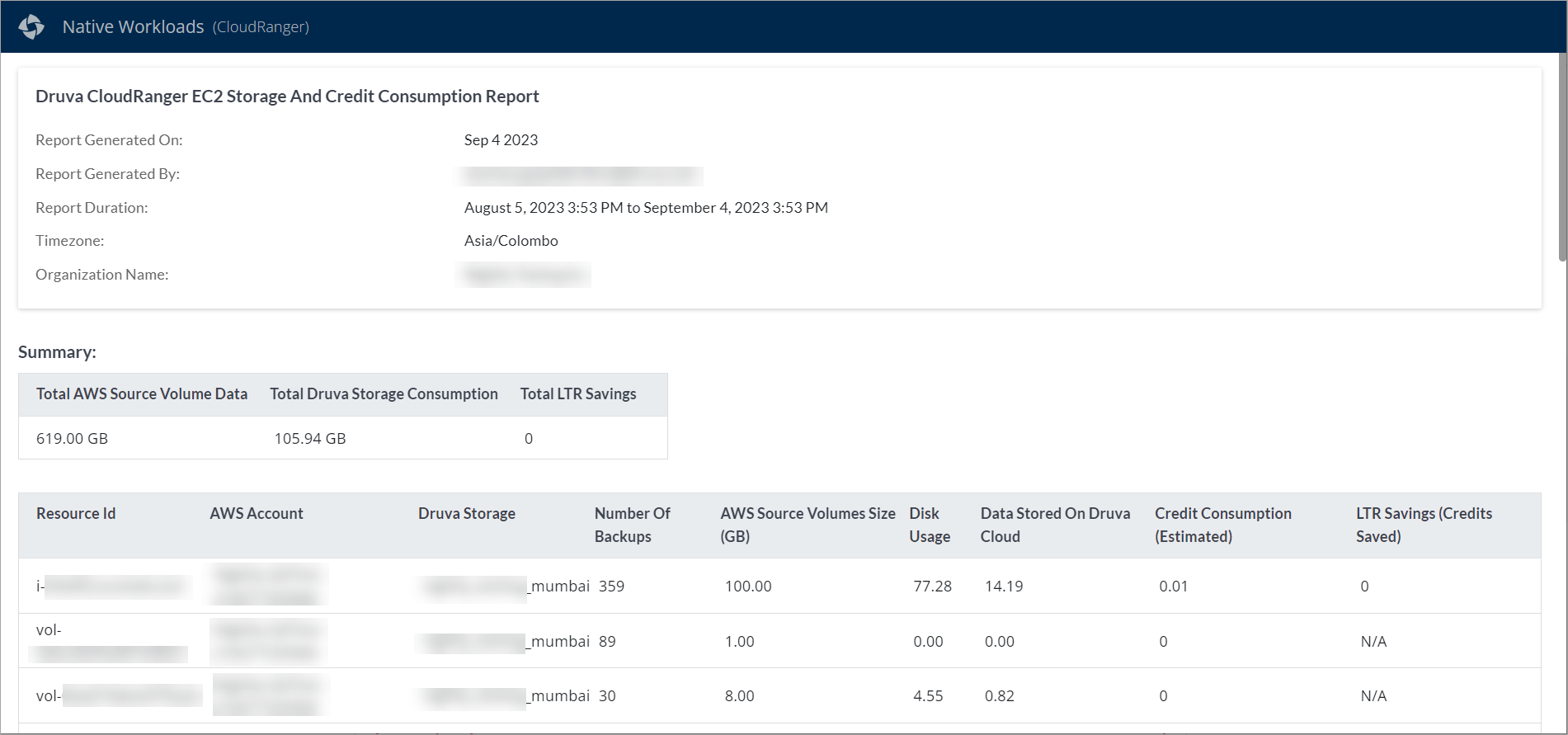
August 16, 2023
Enhancement
Deprecation of Support for AWS Control Tower
Multi-account onboarding via AWS Control Tower will now be unavailable from your Native Workloads management console.
What's Next: If you currently use the feature, you may transition to the native AWS StackSet, which offers enhanced account provisioning and automated template management, ensuring seamless multi-account management.
AWS StackSet is a powerful tool that delivers functionality similar to AWS Control Tower, while offering a more dynamic and customizable approach to multi-account management. For more information, see Configure Multiple AWS Accounts.
No immediate action is required. If you have questions on the deprecation, contact Support.
July 6, 2023
Enhancement
Enhancements to Policy Schedules for Backup to Druva Cloud
The backup schedule for a policy enabled to backup data to Druva Cloud can be set to an hourly frequency or higher. Policies enabled for backup to Druva Cloud will now be executed at a minimum frequency of an hour.
When updating an existing policy to backup data to Druva Cloud, a validation displays if the backup frequency is lower than an hour. For more information, see Manage Backup Policies.
May 29, 2023
Enhancement
Enhancements to Resource Rules within Backup Policy Workflow
You can now view and download the list of resources identified as part of Resource Rules within a backup policy. You may use the search or filter feature to locate specific resources by Resource Type or Region.
If the resource rules defined filter duplicate resources, the duplicate rule will be labeled by a ![]() icon on the management console. You can still create rules that identify duplicate resources, but these will be flagged, and you may choose to edit the rule as appropriate.
icon on the management console. You can still create rules that identify duplicate resources, but these will be flagged, and you may choose to edit the rule as appropriate.
For more information, see Specify Resources for Backup.
May 18, 2023
New Feature
EC2 Storage and Credit Consumption Report for Backups on Druva Cloud
The EC2 Storage and Credit Consumption report offers insights into the backup-wise storage and credit consumption for individual EC2 resources in an organization. The report provides information on consumption at the resource level, with associated details on backup and disk usage, estimated credit consumption, and the LTR savings within the chosen period.
With a granular view of the following data aside from the status of each storage consumption job run for each resource, you may analyze your consumption and initiate appropriate action:
- Total AWS Source volume data (customer’s source data as per the filter selected) (GB/TB)
- Total Druva Storage Consumption (for All EC2 resources that are backed up to Druva Cloud in the selected filter) (GB/TB)
- Total LTR saving credits (total credits saved on data stored in cold tier)
For more information, see Reports.
March 1, 2023
New Feature
Long Term Retention of EC2 and EBS Snapshots on Druva Cloud
With Long Term Retention, you can now leverage Druva’s AWS Deep Archive for EC2 backups using a simplified, policy-based solution to automatically move backed-up data to the cold tier. Configure LTR for EC2 to better manage your enterprise storage requirements as well as optimize TCO.
Long Term Retention is currently available only on policies configured to backup EC2 and EBS snapshots to Druva Cloud.
You may configure Long Term Retention (LTR) on backup policies with the LTR-eligible retention period. A one year retention is required before you can go ahead and enable LTR for EC2. Once enabled, you can continue to monitor savings via LTR, and restore snapshots from the cold tier.
For more information, see Long Term Retention. Have more questions? Refer to the LTR FAQs.
Note: The availability of the Long Term Retention (LTR) feature is limited to Enterprise and Elite editions. To access this feature, contact your Druva Account Manager or Support.
February 13, 2023
Enhancement
Filter Backups Jobs executed Manually or via a Policy
You can now filter the backup jobs based on whether they were executed manually or based on a policy-based backup schedule.
The Generated filter allows you to select backup jobs initiated Manually or By Policy. If you select By Policy, proceed by selecting a backup policy to filter associated jobs. The Policy Name column displays the appropriate backup policy for jobs generated automatically.
For more information, see View Jobs.
January 16, 2023
Enhancement
Restore Snapshots to an Instance using Associations
Use the Association functionality to create an association between resources as a copy or a replacement of the original instance. You can now Restore EBS snapshots on Druva Cloud to an instance using Associations. When you restore snapshots using Associate as A Replacement, you may also choose to add the restored instance to the original backup policy so it continues to be backed up based on the existing policy schedule.
For more information, see Restoring Snapshots to an Instance.
October 19, 2022
Enhancement
Enhancements to Resource Rules within ADR Workflow
You can now filter resources by a Backup Policy when defining Resource Rules as part of your Disaster Recovery Plan. Aside from the existing criteria including Resource IDs, VPCs, and Tags, you can also select one or more backup policies defined within the chosen Account.
Resource Rules help identify resources that you wish to recover from the source environment. Once you define the filter criteria and associated values, the resources that match all the selected filters within the source environment will be included as part of the Rule.
For more information, see Create a Disaster Recovery Plan.
September 27, 2022
New Feature
Prevent malicious or accidental deletion of snapshots using Data Lock
Data Lock prevents modification, deletion, or tampering of business-critical data. Immutability has gained widespread attention with rising ransomware attacks, which can adversely impact enterprise data security.
Immutable snapshots play a key role in your organization’s business strategy and data recovery plan. Once enabled at the policy level, Data Lock ensures that the retention for immutable snapshots cannot be altered, thus safeguarding critical snapshots from a rogue administrator or threats owing to compromised credentials.
Note: Data lock, by default, is available only to Enterprise and Elite customers.
For more information, see Data Lock. Have more questions? Refer to the Data Lock FAQs.
Customer action required: None.
August 3, 2022
Enhancement
Update to Existing Druva CloudRanger Roles
Experience a simplified user management with a unified Admin role, merging the existing Write and Admin roles. With this enhancement, administrators on Druva CloudRanger with Write privileges will migrate to the Admin role, at the Organization and the Account level. Users with view-only permissions will remain unchanged.
Administrators can now grant privileges within two levels of access:
- Admin access: Administrators can create or edit Backup Policies, Server Schedules, and DR plans, as well as provision new users or modify access privileges.
- Admin view access: Users with view-only access can review existing Backup Policies, Server Schedules, and DR plans, but will not be allowed to create or edit predefined policies or plans.
For more information on user management, see Manage Administrator Roles.
Customer action required: No user action is required.
July 21, 2022
New Feature
AMI Deletion Report
The AMI Deletion Report provides a summary of AMIs that have been deleted, either manually or as part of the policy-level retention specified. You can now gather a comprehensive view of all AMIs deleted across one or more accounts, over a 7-day, 30-day, or 90-day period.
For more information, see Reports.
July 14, 2022
New Feature
Introducing Support for AWS Recycle Bin for EBS Snapshots
With Recycle Bin, you can now recover EBS snapshots from accidental deletion by setting a custom retention for deleted snapshots. You can enable Recycle Bin for all snapshots in an account, AWS region, or a subset of them based on tags, and configure the retention period for deleted snapshots. You can choose to recover these deleted snapshots within the retention window. Recovered snapshots retain all metadata including tags, descriptions, and sharing permissions.
Key advantages
- Business continuity: Protect business-critical data against accidental deletion to ensure business continuity
- Data security: Safeguard backups from malicious threats and attacks
- Data Governance: Ensure retention of critical snapshots as part of regulatory compliance
Customer action required: To get started with AWS Recycle Bin, you will first need to configure your resources using appropriate tags. Once resources are identified, all associated snapshots will continue to reside in recycle bin based on the pre-defined retention criteria. You may choose to retrieve these snapshots within the retention period, right from your management console.
For more information, see AWS Recycle Bin Support.
Note: The availability of this feature is by default limited only to customers with Enterprise and Elite licenses.
July 6, 2022
Upcoming Enhancement
Role Migration for Druva CloudRanger Administrators
Starting mid-July 2022, administrators on Druva CloudRanger will migrate to a unified Admin role, merging the existing Write and Admin roles, at the Organization and the Account level. With this migration, the user management will be simplified to include the Admin roles and users with view-only permissions.
Customer action required: No user action is required. The migration will be managed by the Druva CloudRanger team.
For more information on the role migration, contact Support.
June 22, 2022
Enhancement
Resource Orchestration Using Tags
Resource Tags are standardized, case-sensitive key-value pairs that act as metadata to help identify and organize your AWS resources. The Add Tags functionality allows you to specify the key and an associated value, as part of managing resources for disaster recovery, global policies, and script orchestration.
For more information, see Resource Tags.
May 11, 2022
New Feature
Announcing EC2 Backup to Druva Cloud
This feature has limited availability. To know more about limited availability and sign up for this feature, contact Support.
With Druva Data Resiliency Cloud, you can now leverage a cloud-native solution that is designed to effectively manage your data protection strategy to ensure business continuity, compliance, and e-Discovery.
Storage optimization is an ongoing process of evaluating your data storage and choosing a cost-effective storage solution. Druva Data Resiliency Cloud brings some key advantages:
- End-to-end protection: Snapshot orchestration for rapid data recovery with secure, air-gapped backups that enable ransomware protection.
- Cost benefits: Transition snapshots to lower-cost storage with substantial cost savings on long-term retention and cold tier support.
- Dedupe capabilities: Global deduplication to minimize data redundancy and optimize storage utilization.
- Security: Data encryption leveraging AWS key management system (KMS) with best-in-class SaaS security, ensuring encrypted air-gapped backups.
- Ease of use: Managed backup solution with global visibility and control, and simplified backup management to protect resources across AWS accounts.
The overall data protection workflow on Druva Cloud is illustrated below:
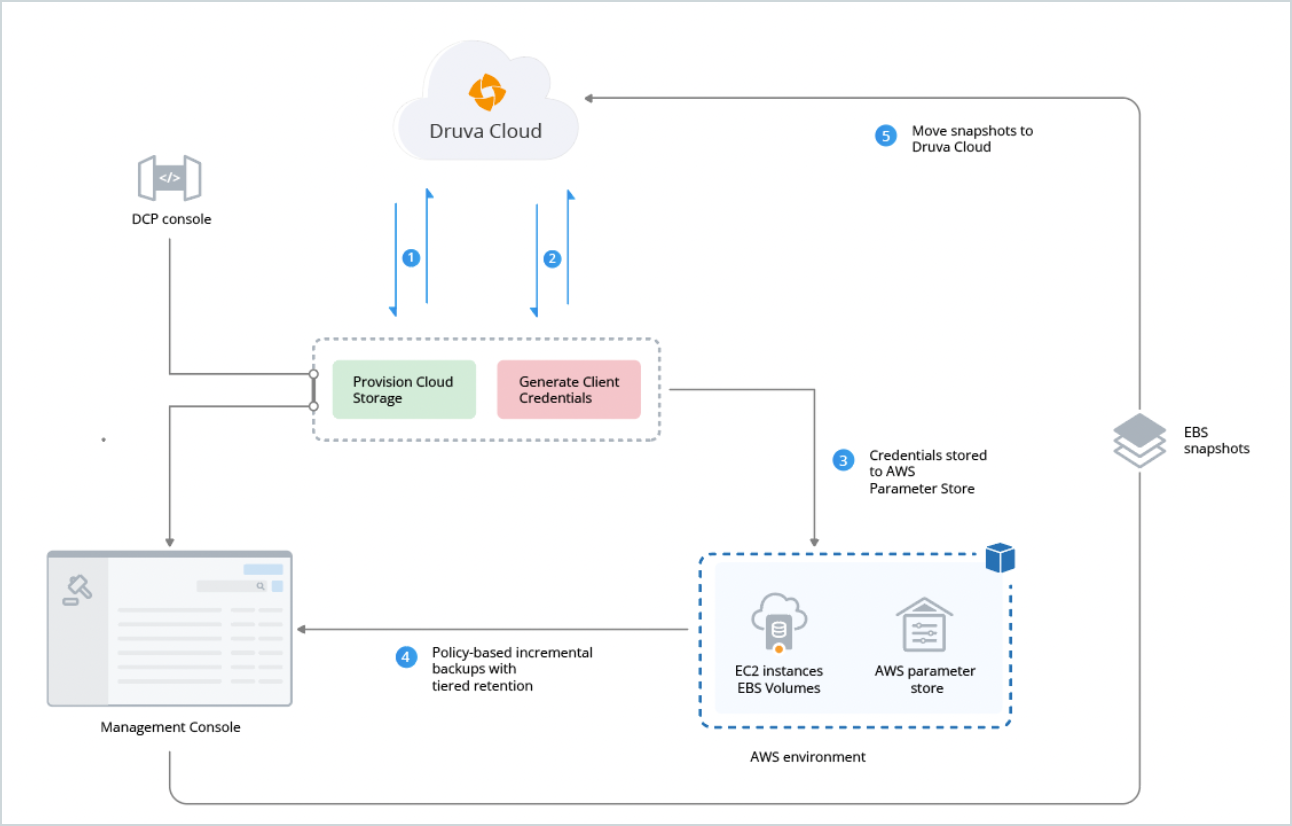
Getting Started with Druva Cloud
To get started, you will first need to provision storage on Druva Cloud. Once you initiate a storage request, this triggers a Support ticket to provision the storage on Druva Cloud based on your agreed credit limits.
Note: If you are currently not set up to use your SSO credentials via Druva Cloud Platform, you will first need to get your DCP account configured. On initiating the cloud storage request, Druva Support will configure the required credentials for your Druva Cloud Platform account. For more information, see Getting Started with EC2 Backup to Druva Cloud.
March 10, 2022
Enhancement
Restore Archived AMIs
You can now restore AMIs archived to S3 storage, with options to restore backups across Accounts or Regions.

You can choose to restore AMIs across accounts and regions, archived or otherwise.
Note: The EBS Backups page presents filter options to display Snapshots and S3 Archive, while the EC2 Backups will, by default, display AMIs and S3 Archive.
For more information, see Restore Archived AMIs.
Disaster Recovery Workflow Enhancements
Runbooks are standardized SOPs and that you can now enable as part of your ADR testing strategy. Use Runbooks to automate server shutdown or restart based on your DR failover plan testing parameters:

Note: Enabling the Shutdown source resources while testing when failover occurs runbook on test plans running within a Production environment will shut down all associated Production resources.
For more information, see Automated Disaster Recovery Workflow.
February 22, 2022
Enhancement
Disaster Recovery Workflow Enhancements
With Sync Schedules, you can now automate your environment cloning by periodically synchronizing a target environment with the source. Sync Schedules bring improved flexibility to schedule the cloning of your source AWS environments, ensuring that your target environments are synchronized with the source environments based on a user-defined schedule.
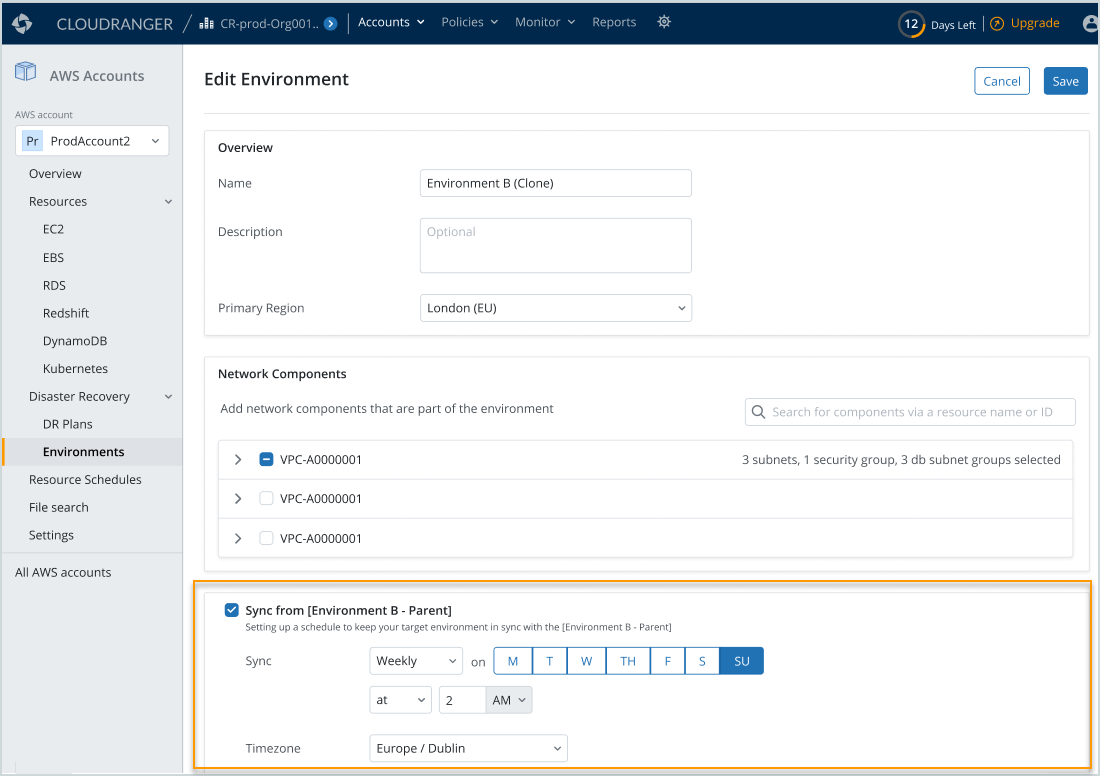
You can define a Sync Schedule only for a cloned environment, that is, the target environment on which the DR failover will be initiated. For more information, see Automated Disaster Recovery Workflow.
Note: To enable this feature, you will need to update your AWS Access Role by deploying the latest CloudFormation template for each account in which you intend to set up schedules. For more information, see Update Existing AWS Access Roles in Druva CloudRanger.
February 15, 2022
Enhancement
EBS Snapshot Restore User Interface Enhancements
With this enhancement, you will experience a revamped user interface with enhancements to the EBS Snapshot Restore workflow. This redesign offers an intuitive user experience to quickly select the appropriate restore approach, and then proceed with customizing the restore-specific parameters.
New access point: Restore Selection
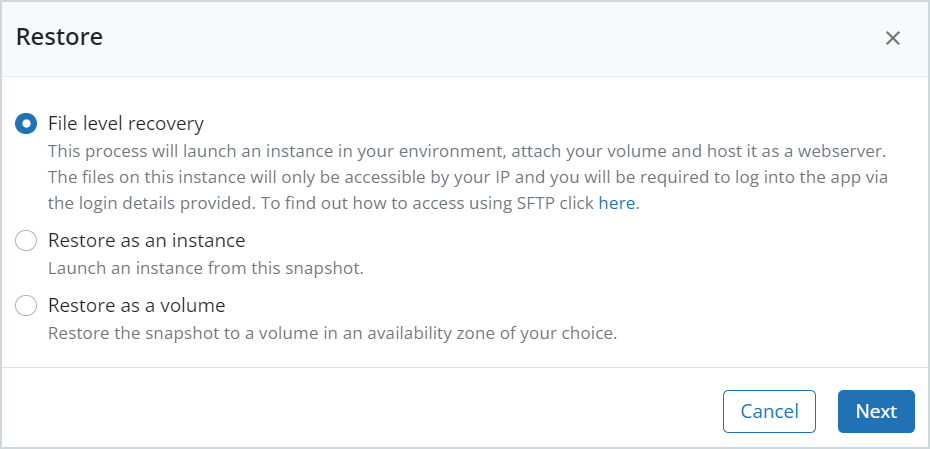
On your EBS Backups page, click the Restore option and then select the restore type you wish to proceed with. The File Level Recovery option is selected by default.
Browsable Snapshots
EBS snapshots that have been indexed for search will now include a Files tab to locate browsable snapshots right from the Backup details page.
For more information, see Restoring EBS Snapshots.
January 27, 2022
Enhancement
Security Enhancements to File Level Recovery
The file-level recovery functionality allows you to initiate a recovery instance and choose the files you wish to recover. Druva CloudRanger launches an instance in your environment and files restored on this instance will only be accessible through your IP.
With the new security enhancements, you will now need to provide snapshot-specific authentication to access your temporary instance.
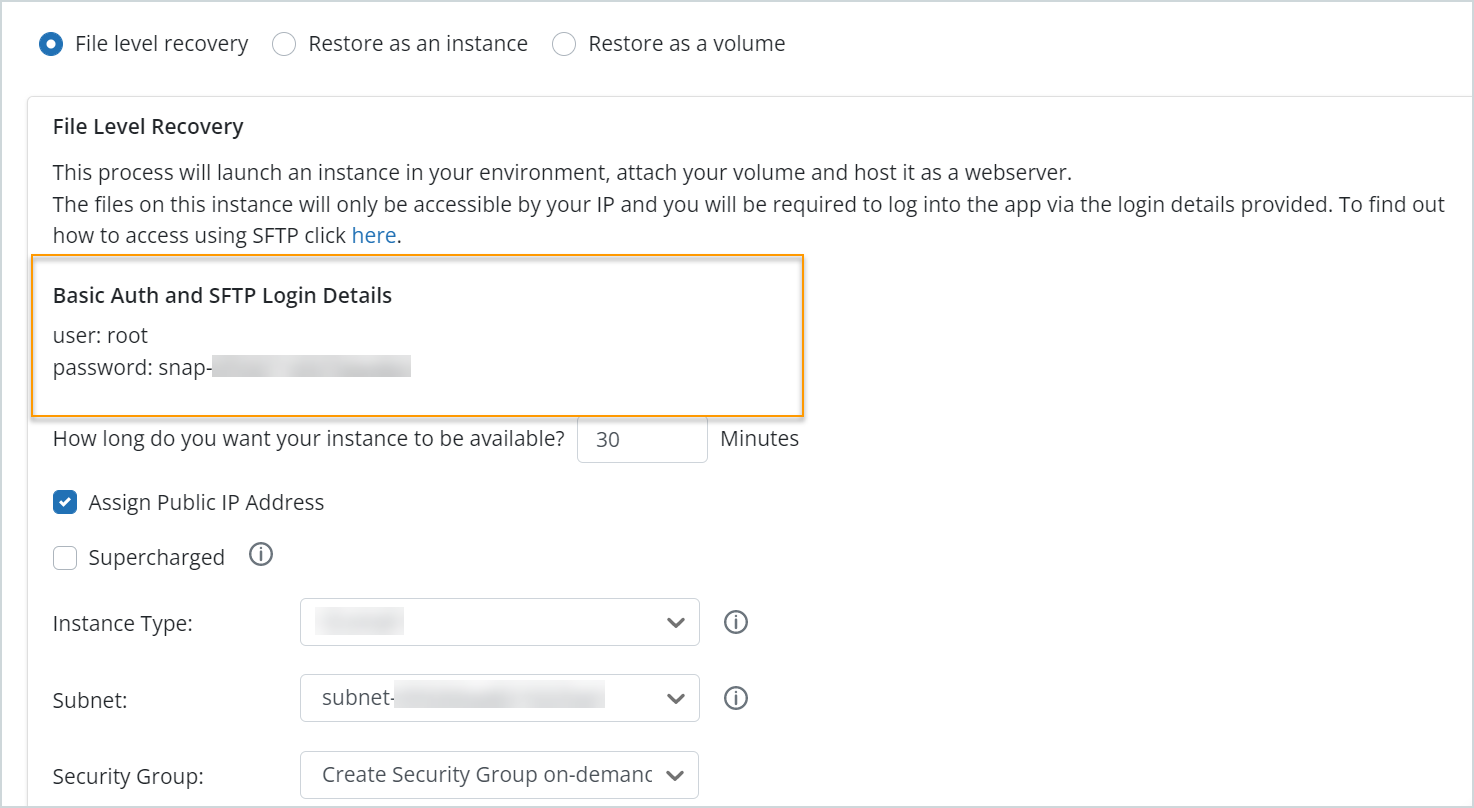
To access your restored files, you will need to provide the following authentication (as displayed on the Restore page, highlighted above):
Username: root
Password: Snapshot ID
For more information, see Restoring Snapshots with File Level Recovery.
January 6, 2022
New Feature
EBS Snapshot Archive
EBS Snapshots Archive is a low-cost storage tier that allows you to archive rarely accessed snapshots, saving up to 75% in storage costs. You can now transition your rarely accessed snapshots to EBS Snapshots Archive, significantly reducing costs while retaining long-term availability.
Archived snapshots will have a minimum retention period of 90 days, with options to retrieve archived snapshots within 24-48 hours. Once retrieved, a snapshot can be used to recover an EBS Volume.
Key Advantages
Archiving EBS snapshots offers the following benefits:
- Cost-effective Storage: Transition snapshots to lower-cost storage tiers to achieve up to 75% storage cost savings.
- Snapshot Retrieve: Seamless retrieval of EBS snapshots, ensuring data availability.
- Cold Storage: Archive EBS snapshots as part of long-term retention.

For more information, see EBS Snapshot Archive.
Archived release notes
For release notes of previous cloud updates, see the following articles:

